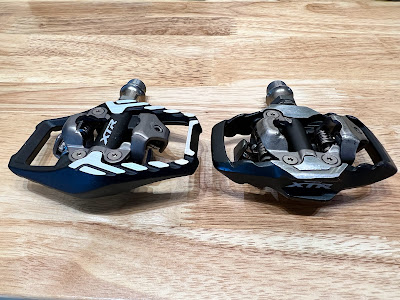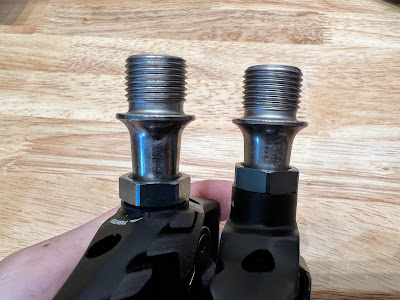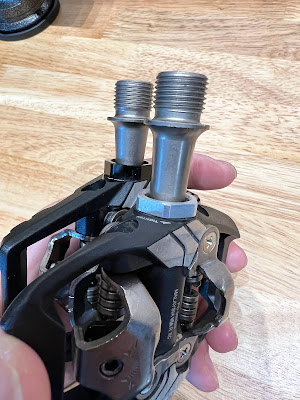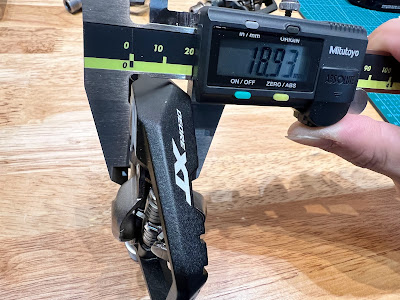Previously when I was just a beginner SPD user, I prefer the use of pedals with SPD on one side, and a flat platform on the other side. This allows me the flexibility to use SPD shoes or normal flat shoes on the same bike, depending on the type of ride. My favourite pedal is the PD-A530, which has been replaced by PD-EH500.
More recently, I realized that on some bikes, I will only ride them while wearing proper cycling shoes, which in my case means SPD shoes. This applies to almost all my full sized bikes, such as the Focus Paralane commuting bike and the Cervelo Aspero gravel bike.
In those cases, there is no need for a flat platform side on the pedal. Rather, it is best to have SPD on both sides of the pedal, so that I can clip in easily regardless of the pedal orientation.
After the bike fitting done at LOUE Bicycles, I eventually decided to use pedals of different stack height on left and right sides, in order to balance out the unbalanced leg length and hip rotation.
That is how I eventually ended up with so many different pedals, as I only need one side of pedal from each set, to get different stack heights. Anyway this gives me a chance to compare all these different pedals.
XTR PD-M9020
XTR PD-M9120
Deore XT PD-M8020
Deore XT PD-M8120
PD-M9120 and PD-M8120, both are Trail SPD pedals with a full cage.
I will be making a few different comparisons, mainly XTR to XTR, Deore XT to Deore XT across different generations, and also between XTR and Deore XT for the same generation.
XTR PD-M9120 Trail SPD pedals.
XTR PD-M9120 on the left, vs the older XTR PD-M9020 pedals on the right.
M9120 is 197 grams per side, giving a weight of 394 grams per pair.
M9020 is lighter at 186 grams per side, giving a weight of 372 grams per pair.
For this case, the newer XTR pedal is actually heavier, as the cage is bigger. Check out the side by side comparisons below.
M9120 platform has a longer cage, with more machined surfaces for a sharper appearance.
M9120 cage is wider as well for better foot stability.
Finally, M9120 pedals sticks out more as well, as part of the larger cage platform.
M9120 pedal spindle has a longer exposed section that is not covered by the nut and pedal body.
One more comparison picture showing the older M9020 on bike vs new M9120.
Next, I move on to the comparison of the Deore XT pedals, across different generations. The Deore XT pedals are said to be more durable than XTR, as well as being much cheaper. The tradeoff is slightly more weight, but as you will see below, the increase in weight is quite small.
Here are the Deore XT PD-M8120 Trail pedals
Older Deore XT PD-M8020 on the left, new Deore XT PD-M8120 on the right.
Deore XT PD-M8120 weighs 215 grams per side, giving a weight of 430 grams per pair.
Older Deore XT PD-M8020 pedals are lighter, at just 201 grams per side and 402 grams per pair.
Similarly to the XTR pedals, the new Deore XT pedals have a larger cage.
The new PD-M8120 pedals have a laser marked surface at the end of the cage, whereas the M8020 pedals do not have.
Quite similar in the amount that they stick out from the crank arms.
In contrast to the newXTR pedals, the new Deore XT pedals have a shorter exposed spindle length.
Finally, let's compare the new XTR pedals vs the new Deore XT pedals. As for the comparison of the older PD-M9020 vs PD-M8020, it has already been done before, check out the other post for the details.
PD-M9120 vs M8120. The XTR pedal has machined surfaces, while Deore XT uses laser etching instead to produce the white surfaces. Otherwise they are very identical.
Lastly, I will compare the pedal thickness, which is related to the stack height. I think that stack height is just roughly half the pedal thickness, although the actual SPD mechanism will affect this measurement slightly.
XTR PD-M9020 pedal thickness is about 17.8 mm
Deore XT PD-M8020 pedal thickness is about 19.9 mm.
XTR PD-M9120 pedal thickness is about 17.6 mm
Deore XT PD-M8120 pedal thickness is about 18.9 mm.
Lastly, just for comparison, the GRX PD-ME700 pedal thickness is 20 mm.
Weight per pair
XTR PD-M9020: 372 grams
XTR PD-M9120: 394 grams
Deore XT PD-M8020: 402 grams
Deore XT PD-M8120: 430 grams
GRX PD-ME700: 480 grams
Pedal Thickness (stack height is approximately half)
XTR PD-M9020: 17.8 mm
XTR PD-M9120: 17.6 mm
Deore XT PD-M8020: 19.9 mm
Deore XT PD-M8120: 18.9 mm
GRX PD-ME700: 20 mm
With this detailed comparison, I can see that the Deore XT pedals add only about 30+ grams per pair over XTR, while being a lot cheaper. It also adds a tiny bit of stack height, which is only about 1 mm more, based on half the pedal thickness.
Therefore, unless you need a pair of pedals that are the absolute lightest and also lowest stack height, the Deore XT pedals are a great deal for practically all occasions.

























No comments:
Post a Comment
Every comment is moderated before publishing due to spam bots. If you don't see your comment yet, it is likely that it is currently being reviewed. Thank you for your patience!